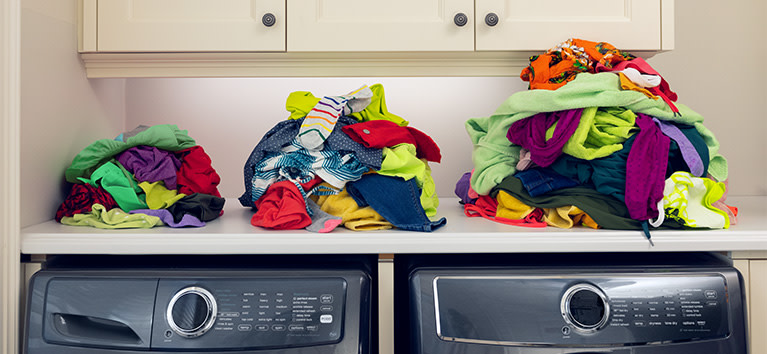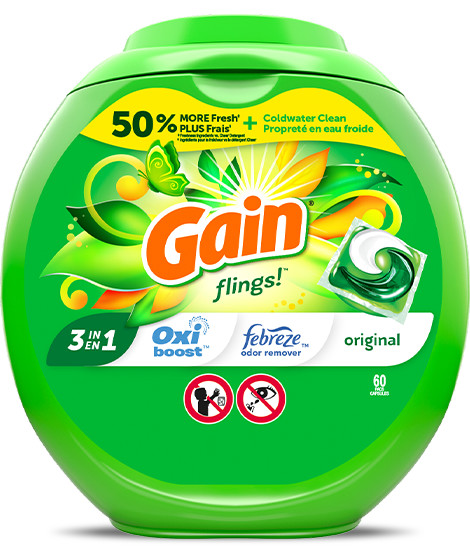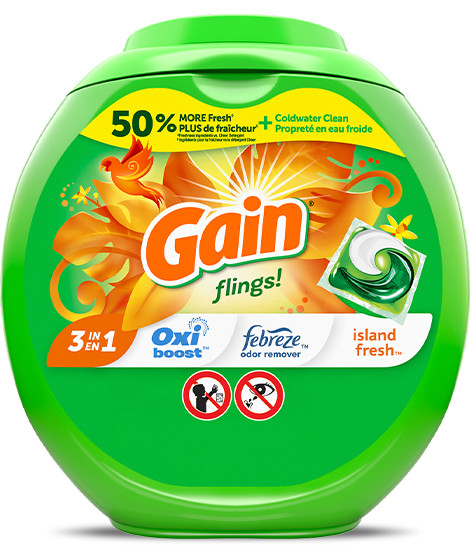We may be in the laundry business, but we know that almost no one wants to spend any more time doing laundry than they have to. And we’re all guilty of it… stuffing those last few dirty pairs of pants into an already full washing machine just so we can have an empty dirty laundry hamper. Sure, you may feel accomplished at the moment having gotten rid of your dirty laundry, but you’ll probably pay for it when the wash cycle completes.
And although we may not enjoy doing laundry any more than you, at Gain we are passionate about doing laundry and getting it as fresh and clean as we can. That’s why we’ve written this handy guide to help you optimize the size of your laundry loads. By taking the time to understand how to load a washer properly, you’ll be well on your way to cleaner, brighter, fresher-smelling clothes.
What Does Washing Machine Capacity Mean?
The “capacity” of the washer tells you how big the space in its drum is and is measured in cubic feet, being a product of the drum’s circumference and depth. The larger the cubic footage in a machine washer, the larger the load it can accommodate. Generally speaking:
Compact Washers: 2.3 – 2.45 Cubic Feet
Standard / High-Efficiencey (HE) Top-Load Washers: 3.1 – 4 Cubic Feet
Front-Load Washers: 4.2 – 5 Cubic Feet
To calculate your own washer’s capacity, you can consult your owner’s manual or you can measure it yourself. To measure your washer capacity yourself, get a tape measure and plug the following measurements into this formula:
(Radius of Drum x Radius of Drum) x Pi (3.14) x Depth of Drum = Washer Capacity in Cubic Feet
How Much is a Load of Laundry?
One of the best ways to quickly calculate your laundry load size is using your own arms. Typically, an easy armful of laundry is a medium or regular load while a full arm load, or one that leaves you barely able to carry it all, is a large load. Anything more than one armload of laundry is an extra-large load.
Load Your Washer By Load Capacity
Now that you better understand the capacity of your machine washer’s drum, it will be easier for you to determine proper laundry load size and detergent dosage. It’s important not to overfill your washer in order to properly clean all your fabrics while also making the most of your time, energy, and laundry resources.
Medium/Regular Load
Regardless of washer capacity, when the drum is about half full of fabrics, this is a medium or regular-sized load. If you can scoop up your laundry in an armload or less, then that’s about the size of a regular load.
Large Load
Once your washer drum is anywhere from halfway to three-quarters full, you’re dealing with a large load of laundry. When you pick up laundry and have to use both arms to handle the full load, that’s a large load of laundry.
Extra-Large Load
Anything more than three-quarters full constitutes an extra-large load. Care will need to be taken here not to overfill or over-dose on the detergent in these cases. When you have to make two trips to the washer because two arms aren’t enough to carry it all, then you’re dealing with an extra-large load of laundry.
Once you’ve calculated load size and have loaded the washer, it’s time to add your favorite Gain detergent to the dispenser and start your wash cycle.
How Much Does the Average Load of Laundry Weigh?
Generally speaking, while the number of clothing items in a load will vary, a medium or regular-sized load of dirty clothes weighs around 6 pounds. Large loads of laundry weigh about 11 pounds and extra-large loads about 21 pounds.
While these are good baseline numbers, when it comes to washing things like large blankets, towels, or other expansive or bulky items, each individual item may constitute its own wash load.
Frequently Asked Questions
How do you determine load size?
When it comes to understanding laundry load size, armloads are a great way to measure. A load of laundry that can be carried easily with both arms (armload) is a medium or regular size load of laundry. A load of laundry that fills both arms completely is a large load. A load of laundry that takes two armloads, or two trips to the machine, is an extra-large load.
How big is too big of a load?
This will vary depending on the size of your machine washer and the washing drum as well as the type of washing machine you own. For example, high-efficiency (HE) washers use less water and can be easily overloaded if loaded carelessly. In any washer, enough space has to be left for clothes to tumble freely and water to flow between them, fully mixing the detergents and soaps needed for cleaning.
How do you know if a load is too big?
There are quite a few telltale signs that let you know when you’ve overloaded your washer. If your clothes come out still dirty, stains aren’t lifting, or odors persist, then there’s a good chance you’re overloading the washer. Additionally, if you notice detergent stains or residue on your clothing, this could mean your clothing is soaking up too much of the available water, not allowing the detergents to dissolve fully.
What is the best load size for a washing machine?
The best load size for a washing machine is the one that gets your laundry the cleanest. No really! Determining the right load size for you is a result of a number of factors and will likely require some experimentation on your part. But generally speaking, the right load size is the one that gives your machine enough room for clothes to tumble, detergents to fully mix and dissolve in the water, and enough agitation to lift tough dirt and stains.
It’s important to keep your laundry products up, closed and safe – away from children. If at any time you have difficulty closing your package, please reach out directly to our team.
RELATED ARTICLES

TIPS FOR LAUNDRY ROOM STORAGE
When it comes to dangers around the home, few of us consider the laundry room to be an area we need to be particularly concerned about.

LAUNDRY SAFETY TIPS
On the surface, doing laundry may seem like one of the least dangerous tasks we perform at our house.

HOW TO DO LAUNDRY
Whether you consider yourself a laundry beginner or you have a lot of experience from years of loading the washer and dryer, there is always room for improvement.











